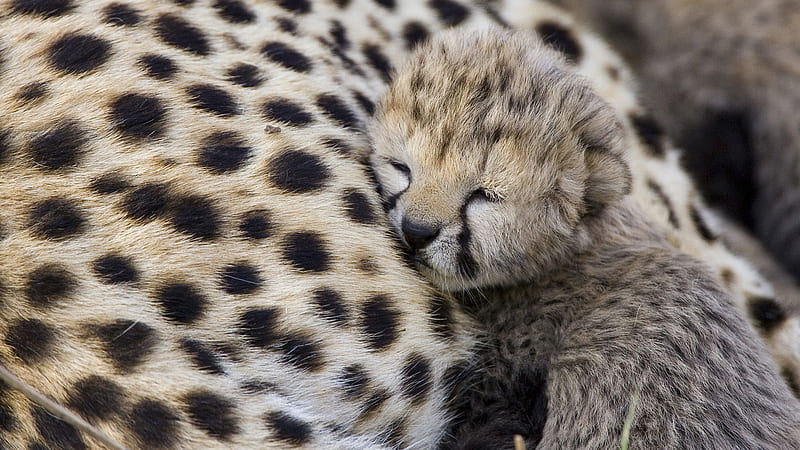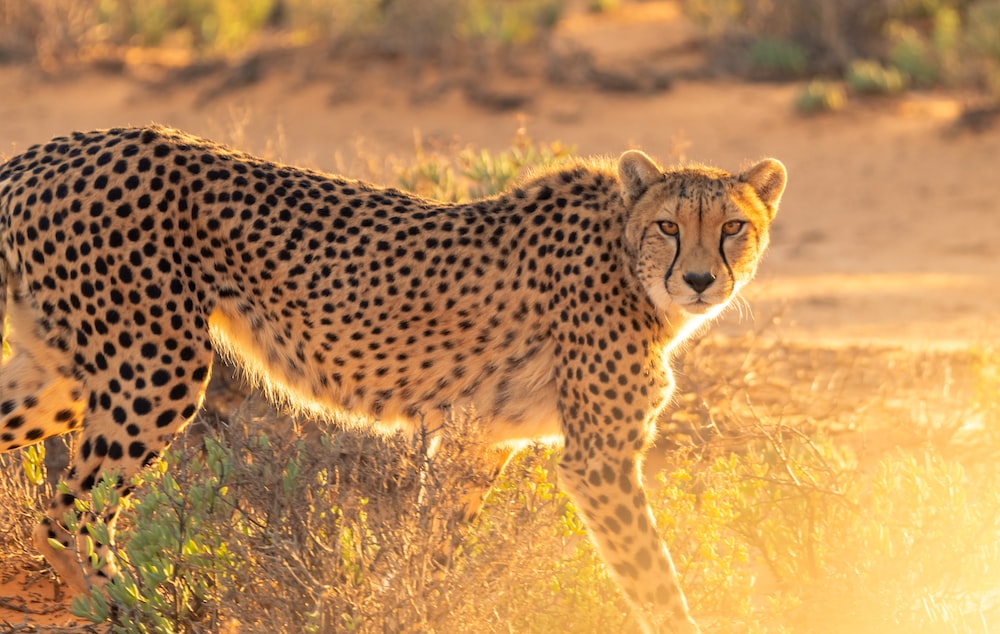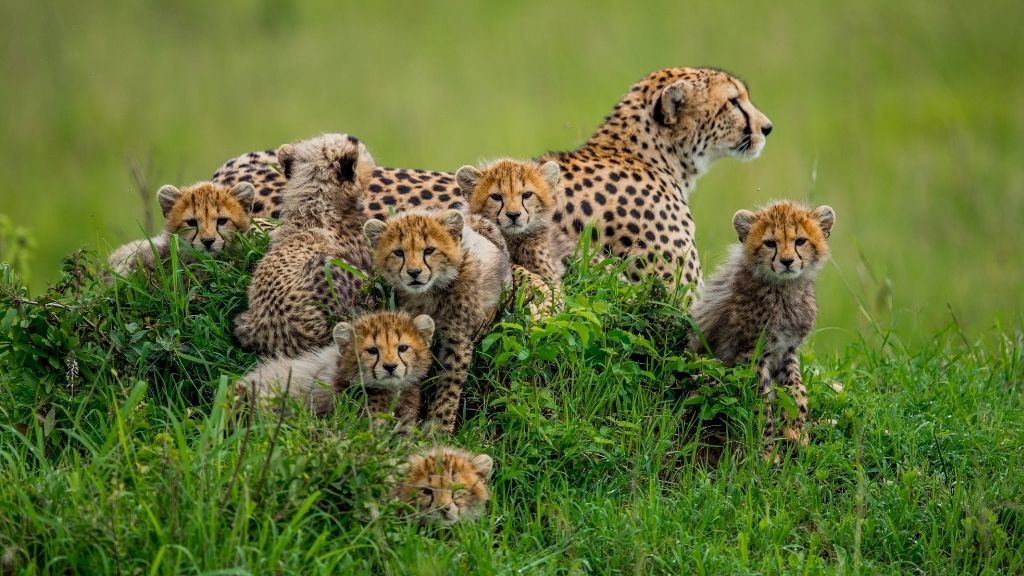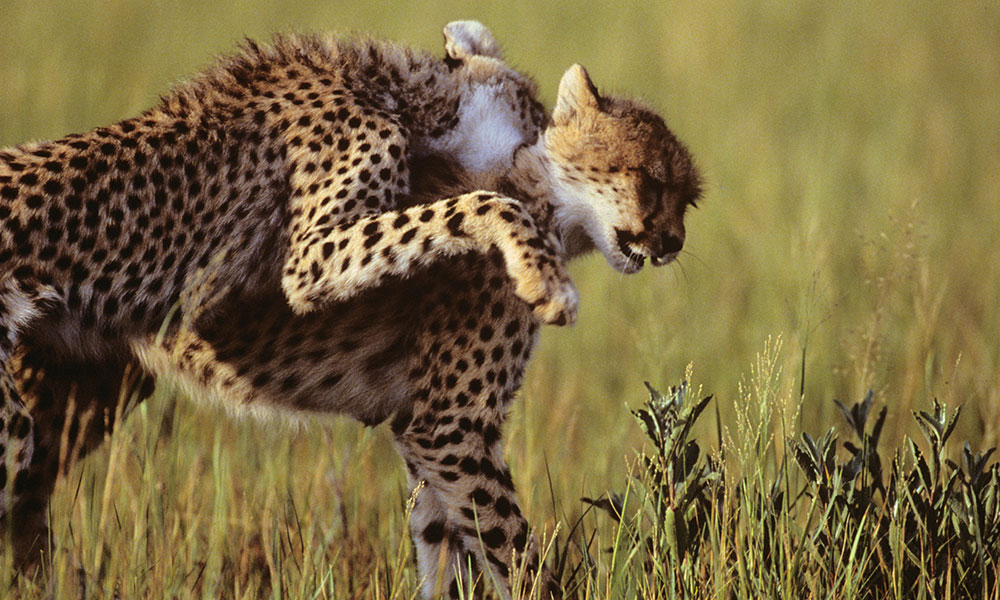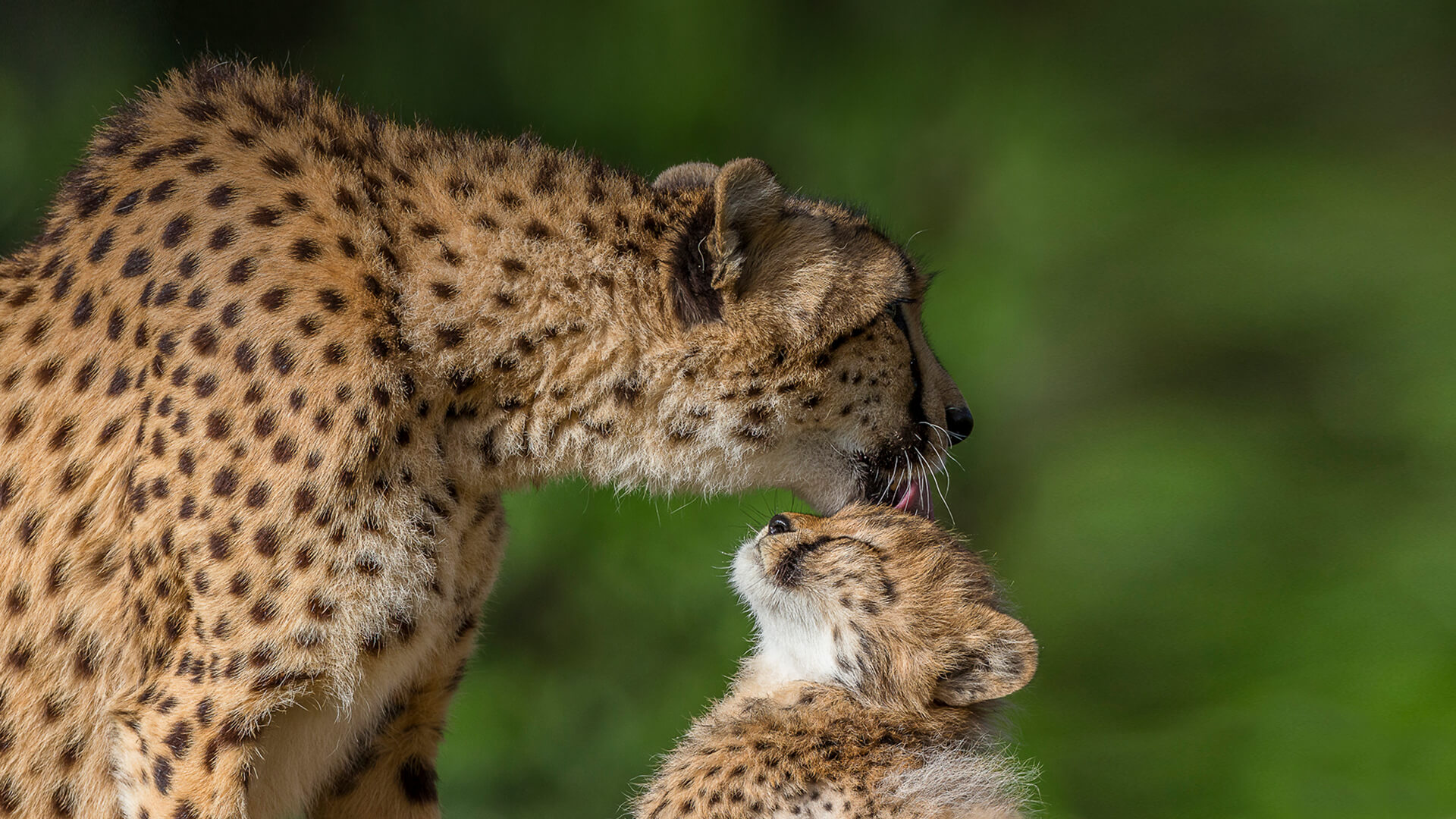Cheetah!
The cheetah is the fastest land animal, with short distances reaching speeds of 60 or even 70 miles per hour (97 or 113 kilometers per hour).
These cats can turn abruptly and quickly while traveling at great speeds in search of prey. From their long, slender limbs and firm foot pads to the flexible spine that gives them their lengthy stride, cheetahs' physique are specially built to help them reach top speeds.
The tawny coats of cheetahs are renowned for being covered in black spots, each of which is arranged in a distinctive pattern to aid the animals in distinguishing one another. From the inner corners of their eyes down to both sides of their lips, strong black lines run like tears, and the ends of their bushy tails feature black rings.
The cheetah's keen vision aids in its ability to locate prey during the day. Because of how well its spotted coat mixes with the long, dry grass of the plains, cheetahs are difficult to notice.
Cheetahs are regarded as one of the "big cats" by some biologists due to their size, strength, and propensity for predation. This category also includes jaguars, leopards, tigers, and lions. Cheetahs are the only members of the group who cannot roar, though they can purr.
Throughout eastern and southern Africa, cheetahs can be found in a variety of habitats, however they typically prefer open grasslands.
Cheetahs were once common throughout Asia and Africa, but they are now rapidly approaching extinction. The future of these cats is in danger due to habitat loss and a decrease in the population of their prey.
Take the big cat quiz to see how much you know about these fierce felines. Then, just for fun, see which wild cat you’re most like with our personality quiz.
Diet
Cheetahs can sprint from zero to 80 km/h (50 mph) in just three steps, and they can reach their top speed of 110 km/h (68.35 mph) in just a few seconds. Cheetahs, however, are not long-lived animals, thus the hunt of prey must be well planned.
Cheetahs don't ambush their victim or attack within springing range like the majority of other cats do. The stalking of prey can last for hours or only take a few seconds. The chase starts when the cheetah is within 70 to 100 meters (230 to 330 feet). Most chases take no longer than 20 seconds, and very few last longer than one minute. The average distance traveled is 170 meters (550 feet), however some may pursue for an additional 500 meters (1,640 ft.). Cheetahs rarely make an attack attempt if they are more than 200 meters (650 feet) distant from their victim.
When a cheetah sprints quickly, neither the entire extension of its legs nor the contraction of its legs under the body cause any of its four paws to touch the ground. A full stride from a considerably larger race horse would cover 7 m (23 ft) in a single stride. A cheetah moves along at a speed of 3.5 strides per second or one stride per 0.28 seconds when it is nearing its maximal acceleration.
On their forelegs, cheetahs have a dewclaw that curves. A cheetah will swat at and trip a prey animal with its dewclaw while it is being pursued.
The majority of endeavors fail. However, if the cheetah makes contact, it knocks the prey to the ground and rams its tiny upper canines into the animal's throat, killing it by strangulation or suffocation.
Cheetahs tend to rest through the hottest part of the day, focusing their hunts in the late morning and early afternoon, in contrast to other large carnivores in their area. This tactic could reduce conflict and rivalry between cheetahs and other powerful predators like lions and hyenas.
A cheetah may try to drag its prey to a hiding place first before eating it. Unlike other African predators, cheetahs rarely scavenge dead animals they did not kill. A cheetah must frequently consume its prey rapidly or leave to avoid confrontations because lions, hyenas, and even vultures will drive them away from their kill.
Compared to a mom with cubs, who may make a kill every day, lone adults may hunt every two to five days. Each day, an adult cheetah consumes roughly 6.2 lbs (2.8 kg) of meat. Cheetahs rarely consume alcohol; they typically consume one drink every four days, and maybe just one drink every ten.
Cheetahs consume impalas (Aepyceros melampus), gazelles (particularly Gazella thompsonii), other small- to medium-sized ungulates, as well as the calves of larger ungulate species. Birds, small mammals, and hares (Lepus spp.) may also be taken.
"In the chase between cheetah and deer, most of the times deer wins. The cheetah runs for food; while the deer for life. Purpose is more important than need..." — My brain
Habitat
Cheetahs are tolerant of a wide range of habitats including shrublands, grasslands, savannahs, and temperate to hot deserts. Cheetahs largely stay on the ground but are known to climb trees on occasion.
As recently as 20,000 years ago, cheetahs had a near worldwide distribution and were one of the most widely distributed land animals on the planet. Cheetahs are now found widely but sparsely across Africa, although their populations have significantly disappeared from their historical ranges in the past. In Africa, for example, it's estimated that cheetahs are no longer found in 76% of their former historic range. Cheetahs likely only exist in 6% of their former range in eastern Africa but have most drastically declined in northern and western Africa.
Presently the Asiatic cheetah (A. j. venaticus) is considered restricted to Asia but today is believed to exist only in Iran. In the past, cheetahs in Asia were found from the shores of the Mediterranean and Arabian Peninsula, north to the shorelines of the Caspian and Aral Seas, and west through Uzbekistan, Turkmenistan, Afghanistan, and Pakistan into central India.
Behavior
Cheetahs will live solitarily or in small groups. Adult females tend to live alone except when raising cubs. After leaving their den, brothers will stay together in groups of 2 to 4 called coalitions. They will live with each other for the rest of their lives. These groups can even contain unrelated males, but never females. Females establish large territories and defend them against intruding females. Males also establish territories, but they are generally smaller and overlap into the female territories. These territories will change over time, especially during drought, because cheetahs will follow their prey.
Cheetahs hunt during the day to avoid competition with lions and hyenas who are less active during the day. Cheetahs are very timid and avoid lions and hyenas at all costs. Their fresh kill is often taken by an intruding hyena or lion because the cheetah is too timid and tired to put up a fight. Many times cheetahs are even threatened by their prey. A cheetah is specialized for catching their prey on the run, if a large prey stands its ground a cheetah is almost helpless because it can't take it down. Cheetahs will respond to a larger prey standing its ground by growling and foot(paw) stomping. Sometimes the PREY will even charge the CHEETAH, in which cause the cheetah usually responds by fleeing the scene. The cheetah's speed make it an excellent hunter, but its timid nature and lack of endurance inhibits it from repetitive hunting success.
LifeCycle
There are three stages in the life cycle of the cheetah: cub (birth to 18 months), adolescence (18 to 24 months) and adult life (24 months and on).
The gestation (pregnancy) period for the cheetah is 93 days, and litters range in size from one or two up to six cubs (the occasional litter of eight cubs has been recorded, but it is rare). Cub mortality is higher in protected areas like national parks and wildlife reserves where proximity to large predators is greater than in non-protected areas. In such areas, the cheetah cub mortality can be as high as 90%.
Adult life for a cheetah in the wild is difficult. Cheetahs in the wild (both male and female combined) have an average age span of 10 – 12 years. The average lifespan of an adult male in the wild skews lower (8 years), due in part to territorial conflicts with competing groups of males. Adult mortality is one of the most significant limiting factors for the growth and survival of the wild cheetah population.
“Death is the start of a beginning, life is the start of the end, and the cycle continues forever." — Some nerd on the internet
Facts
- 1.
The planet's fastest land animal is built for super speed, rather than stamina
- 2.
When they do stir, cheetahs can accelerate faster than most sports cars
- 3.
The name cheetah comes from a Hindi word, chita, meaning 'spotted one'
- 4.
Cheetahs have a unique social life among cats
- 5.
Unlike most cats, the cheetah mainly hunts in the day
- 6.
Don't expect a cheetah to roar. Cheetahs only meow!
- 7.
In ancient Egypt the cheetah was considered sacred and a symbol of royalty
- 8.
Cheetahs need their space. They prefer big areas.
- 9.
Cheetahs are under threat from the illegal wildlife trade
- 10.
Cheetahs could be sprinting towards extinction. Their numbers are decreasing...
